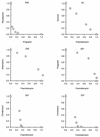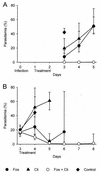In vitro and in vivo synergy of fosmidomycin, a novel antimalarial drug, with clindamycin
- PMID: 12183243
- PMCID: PMC127394
- DOI: 10.1128/AAC.46.9.2889-2894.2002
In vitro and in vivo synergy of fosmidomycin, a novel antimalarial drug, with clindamycin
Abstract
Fosmidomycin acts through inhibition of 1-deoxy-D-xylulose 5-phosphate (DOXP) reductoisomerase, a key enzyme of the nonmevalonate pathway of isoprenoid biosynthesis. It possesses potent antimalarial activity in vitro and in murine malaria. In a recent clinical study, fosmidomycin was effective and well tolerated in the treatment of patients with acute uncomplicated Plasmodium falciparum malaria but resulted in an unacceptably high rate of recrudescence. In order to identify a potential combination partner, the interaction of fosmidomycin with a number of antimalarial drugs in current use was investigated in a series of in vitro experiments. Synergy was observed between fosmidomycin and the lincosamides, lincomycin and clindamycin. The efficacy of a combination of fosmidomycin and clindamycin was subsequently demonstrated in the Plasmodium vinckei mouse model.
Figures



Similar articles
-
Fosmidomycin for the treatment of malaria.Parasitol Res. 2003 Jun;90 Suppl 2:S71-6. doi: 10.1007/s00436-002-0770-9. Epub 2002 Nov 30. Parasitol Res. 2003. PMID: 12937969 Review.
-
Inhibitors of the nonmevalonate pathway of isoprenoid biosynthesis as antimalarial drugs.Science. 1999 Sep 3;285(5433):1573-6. doi: 10.1126/science.285.5433.1573. Science. 1999. PMID: 10477522
-
Prodrugs of reverse fosmidomycin analogues.J Med Chem. 2015 Feb 26;58(4):2025-35. doi: 10.1021/jm5019719. Epub 2015 Feb 12. J Med Chem. 2015. PMID: 25633870
-
Whole-Genome Sequencing to Evaluate the Resistance Landscape Following Antimalarial Treatment Failure With Fosmidomycin-Clindamycin.J Infect Dis. 2016 Oct 1;214(7):1085-91. doi: 10.1093/infdis/jiw304. Epub 2016 Jul 20. J Infect Dis. 2016. PMID: 27443612 Free PMC article.
-
Fosmidomycin as an antimalarial drug: a meta-analysis of clinical trials.Future Microbiol. 2015;10(8):1375-90. doi: 10.2217/FMB.15.60. Epub 2015 Jul 31. Future Microbiol. 2015. PMID: 26228767
Cited by
-
A systems biology approach to uncovering pharmacological synergy in herbal medicines with applications to cardiovascular disease.Evid Based Complement Alternat Med. 2012;2012:519031. doi: 10.1155/2012/519031. Epub 2012 Nov 29. Evid Based Complement Alternat Med. 2012. PMID: 23243453 Free PMC article.
-
In Vitro Antimalarial Activity of Different Inhibitors of the Plasmodial Isoprenoid Synthesis Pathway.Antimicrob Agents Chemother. 2015 Aug;59(8):5084-7. doi: 10.1128/AAC.04161-14. Epub 2015 Jun 8. Antimicrob Agents Chemother. 2015. PMID: 26055383 Free PMC article.
-
Isoprenoid biosynthesis as a target for antibacterial and antiparasitic drugs: phosphonohydroxamic acids as inhibitors of deoxyxylulose phosphate reducto-isomerase.Biochem J. 2005 Feb 15;386(Pt 1):127-35. doi: 10.1042/BJ20041378. Biochem J. 2005. PMID: 15473867 Free PMC article.
-
Sub-inhibitory fosmidomycin exposures elicits oxidative stress in Salmonella enterica serovar Typhimurium LT2.PLoS One. 2014 Apr 21;9(4):e95271. doi: 10.1371/journal.pone.0095271. eCollection 2014. PLoS One. 2014. PMID: 24751777 Free PMC article.
-
Plasmodium IspD (2-C-Methyl-D-erythritol 4-Phosphate Cytidyltransferase), an Essential and Druggable Antimalarial Target.ACS Infect Dis. 2015 Apr 10;1(4):157-167. doi: 10.1021/id500047s. Epub 2015 Mar 2. ACS Infect Dis. 2015. PMID: 26783558 Free PMC article.
References
-
- Ancelin, M. L., M. Calas, J. Bompart, G. Cordina, D. Martin, M. Ben Bari, T. Jei, P. Druilhe, and H. J. Vial. 1998. Antimalarial activity of 77 phospholipid polar head analogs: close correlation between inhibition of phospholipid metabolism and in vitro Plasmodium falciparum growth. Blood 91:1426-1437. - PubMed
-
- Basco, L. K., and P. Ringwald. 2000. Molecular epidemiology of malaria in Yaounde, Cameroon. VI. Sequence variations in the Plasmodium falciparum dihydrofolate reductase-thymidylate synthase gene and in vitro resistance to pyrimethamine and cycloguanil. Am. J. Trop. Med. Hyg. 62:271-276. - PubMed
-
- Canfield, C. J., M. Pudney, and W. E. Gutteridge. 1995. Interactions of atovaquone with other antimalarial drugs against Plasmodium falciparum in vitro. Exp. Parasitol. 80:373-381. - PubMed
-
- Dhawan, V. K., and H. Thadepalli. 1982. Clindamycin: a review of fifteen years of experience. Rev. Infect. Dis. 4:1133-1153. - PubMed
MeSH terms
Substances
LinkOut - more resources
Full Text Sources
Other Literature Sources
Medical

